
A heritage railway or heritage railroad is a railway operated as living history to re-create or preserve railway scenes of the past. Heritage railways are often old railway lines preserved in a state depicting a period in the history of rail transport.
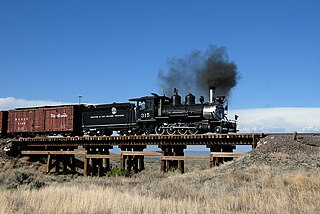
Conservation and restoration of rail vehicles aims to preserve historic rail vehicles.

Confluence Park is an urban park encompassing the confluence of Cherry Creek and the South Platte River in Denver's Lower Downtown (LoDo), a bustling district of 19th-century brick warehouses and storefronts that has been redeveloped since the late 1980s.

The TECO Line Streetcar is a heritage streetcar transit line in Tampa, Florida, run by the Hillsborough Area Regional Transportation Authority (HART), owned by the city of Tampa, and managed by Tampa Historic Streetcar, Inc. It connects Downtown and Channelside to the historic Ybor City district. There is also an "In-Town" trolley-replica bus system that connects Downtown, Channelside, and Harbour Island.

The San Diego Electric Railway (SDERy) was a mass transit system in Southern California, United States, using 600 volt DC streetcars and buses.
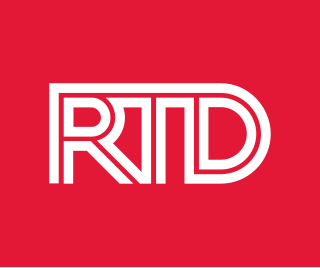
The Regional Transportation District, more commonly referred to as RTD, is the regional agency operating public transit services in eight out of the twelve counties in the Denver-Aurora-Boulder Combined Statistical Area in the U.S. state of Colorado. It operates over a 2,342-square-mile (6,070 km2) area, serving 3.08 million people. RTD was organized in 1969 and is governed by a 15-member, publicly elected Board of Directors. Directors are elected to a four-year term and represent a specific district of about 180,000 constituents.

The Denver Tramway, operating in Denver, Colorado, was a streetcar system incorporated in 1886. The tramway was unusual for a number of reasons: the term "tramway" is generally not used in the United States, and it is not known why the company was named as such. The track was 3 ft 6 in narrow gauge, an unusual gauge in the United States, but in general use by railways in Japan, southern Africa, New Zealand, and Queensland, Australia.

The Fort Collins Municipal Railway operated streetcars in Fort Collins, Colorado, from 1919 until 1951. Since 1984, a section of one of the former routes has been in operation as a seasonal heritage streetcar service, under the same name, running primarily on Spring and Summer weekends. The heritage service is operated by volunteers from the Fort Collins Municipal Railway Society (FCMRS). The streetcar in use on the heritage line, Birney "Safety" Streetcar No. 21, is listed on the National Register of Historic Places.
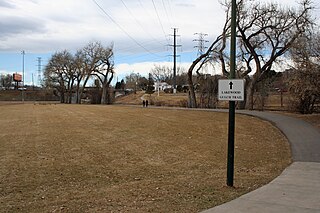
Lakewood Gulch drains a section of Lakewood and west Denver, Colorado into the South Platte River. It is the historic location of the old Interurban Shortline Railway and, in 2008, is a greenbelt that includes Rude Park, Sanchez Park and Lakewood Gulch Park. The gulch passes through Lakewood from west to east before entering the Denver neighborhoods of Sun Valley and Villa Park. It contains a part of the route of the (current) heritage streetcar Platte Valley Trolley and the Denver sections of the creek have an adjacent bike path. According to the Jefferson County Colorado Place Names Directory, "Lakewood Gulch originates on the north east foot of Green Mountain in Lakewood, flows east through Sixth Avenue West Park and Red Rocks Community College and continues east through Lakewood into Denver, where it joins the South Platte River southwest of the intersection of I-25 and Colfax Avenue."

Jefferson Park is a neighborhood and public park that overlooks Downtown Denver, Colorado from its perch across Interstate 25 (I-25). It is located in the area that is called North Denver. Views east from Jefferson Park take in Elitch Gardens Theme Park, The Children's Museum, Denver's Downtown Aquarium, Pepsi Center, the REI flagship store and other attractions in Downtown's Central Platte Valley. Downtown Denver and the Central Platte Valley are quickly accessed from Jefferson Park, using the 23rd Avenue overpass on I-25 and Water Street. In addition, the Light Rail C-Line is located by Empower Field at Mile High in the southern part of the neighborhood.

There are 304 properties and districts listed on the National Register of Historic Places in Denver, the capital of the U.S. state of Colorado.

Sun Valley is a central Denver neighborhood, bordered by I-25 on the east, Federal Blvd. on the west, 6th Avenue on the south and 20th Ave. on the north. It is located in the area known as West Denver.

Villa Park is a neighborhood in Denver, Colorado. Its hilly topography provides panoramic views of downtown Denver and of the Rocky Mountains, particularly from Lakewood / Dry Gulch Park, which divides the neighborhood diagonally.
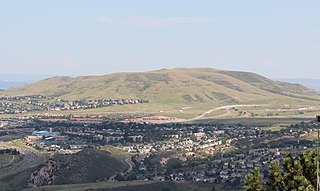
The City of Lakewood is the home rule municipality that is the most populous municipality in Jefferson County, Colorado, United States. The city population was 155,984 at the 2020 U.S. Census making Lakewood the fifth most populous city in Colorado and the 167th most populous city in the United States. Lying immediately west of Denver, Lakewood is a principal city of the Denver–Aurora–Lakewood, CO Metropolitan Statistical Area and a major city of the Front Range Urban Corridor.
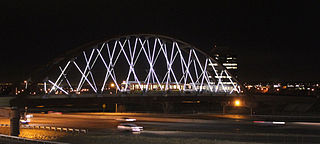
The W Line, also called the West Rail Line, is a light rail line in Denver, Lakewood, and Golden, Colorado, United States. The W Line was the first part of FasTracks to break ground, on May 16, 2007. The line, the only line to traverse the West Corridor, opened for service on Friday, April 26, 2013.

The Astoria Riverfront Trolley is a 3-mile (4.8 km) heritage streetcar line that operates in Astoria, Oregon, United States, using former freight railroad tracks along or near the south bank of the Columbia River, with no overhead line. The service began operating in 1999, using a 1913-built streetcar from San Antonio, Texas. As of 2012, the service was reported as carrying 35,000 to 40,000 passengers per year and has been called a "symbol" and "icon" of Astoria. The line's operation is seasonal, normally during spring break and from May through September.

Decatur–Federal is an at-grade light rail station on the W Line of the RTD Rail system. It is located alongside the banks of the Lakewood Gulch between its intersections with Decatur Street and Federal Boulevard, after which the station is named, in Denver, Colorado. The station is located in the Sun Valley neighborhood, near the point where Lakewood Gulch meets the South Platte River. It is one of two light rail stops that serve Empower Field at Mile High, the home stadium of the Denver Broncos. The stop is adjacent to Rude Park.
The Denver and Intermountain Railroad was an interurban railway that operated 18 miles (29 km) between Denver and Golden, Colorado. Originating as a steam railroad, the Denver, Lakewood and Golden, the line was opened in 1891 and had built an electrified spur leading into downtown by 1893. The company went into receivership and was acquired by the Denver & Inter-Mountain Railway in 1904, changing to simply the Intermountain in 1907 before finally settling on Denver & Intermountain Railroad (D&IM) in 1910. The line was fully electrified at 11,000 volts alternating current in 1909, allowing direct trains to run on city streets to downtown Denver's Interurban Loop. The company was acquired by Denver Tramway the following year, becoming Route 84 in the system. Service ended in 1950 – electrical infrastructure was maintained until 1953 and ownership of the line passed to Associated Railroads, maintained the line for freight as far as Denver Federal Center. The right of way was acquired by Regional Transportation District in the 1990s and rehabilitated to form part of the W Line light rail.

















